Abstract
Photocatalytic H2 production provides an ideal way to alleviate the energy crisis and solve environmental problems. In this paper, the metallic MoS2/WS2 dual cocatalysts are prepared through the in situ growth of 1T-WS2 on the surface of 1T-MoS2 via a solvothermal method. The ternary cross-linked MoS2/WS2/CdS photocatalysts are finally constructed by growing CdS nanorods on MoS2/WS2 cocatalysts. The XRD and TEM results show that ternary cross-linked MoS2/WS2/CdS photocatalysts with close interfacial contact were successfully synthesized. The results of Photoluminescence (PL) and photoelectrochemical tests show that MoS2/WS2/CdS has the lowest hydrogen evolution overpotential and the highest charge separation efficiency. This is due to the synergistic effect between WS2 and MoS2, which further accelerates the transfer of photogenerated electrons and inhibits the recombination of carriers. The hydrogen evolution rate of the MoS2/WS2/CdS composite is 12.12 mmol·g−1·h−1, which is 4.57 times that of pristine CdS. The AQY at λ = 420 nm is 58.9%.
1. Introduction
Today, faced with the serious energy and environmental problems caused by the excessive use of fossil energy, there is an urgent need to develop green, economical and renewable energy. Photocatalytic water splitting to produce hydrogen has attracted extensive attention due to its ability to produce “green hydrogen” (without producing additional CO2) [,,]. CdS is one of the most studied visible-light photocatalysts because of its narrow band gap and appropriate band position. The band gap of CdS is 2.2~2.4 eV, and the light adsorption edge is 520~560 nm. Its conduction band (CB) and valence band (VB) potentials are −0.65 eV and +1.7 eV (NHE, pH = 0), respectively, exceeding the redox potential of water decomposition and providing almost perfect thermodynamic conditions [,,]. However, the high recombination rate of photogenerated carriers on the surface of CdS results in low photocatalytic activity. Although Pt-based metal cocatalysts have shown good hydrogen evolution performance in photocatalytic reactions, their scarcity and high cost limit their application [,]. In recent years, researchers have found that some non-noble metals have suitable band gaps, which can significantly improve the photocatalytic performance of photocatalysts, meaning that they may represent alternative materials for noble metals [].
Transition metal dichalcogenides (TMDs) have been found to possess high catalytic hydrogen evolution performance due to their unique two-dimensional layered structure, thus becoming a very promising alternative to precious metals. WS2 and MoS2 are typical transition metal disulfides in which the metal layer and the S layer are bonded by a weak van der Waals force, which is more adjustable than the covalently bonded structure [,,]. Both WS2 and MoS2 have two different phases: a triangular prism (2H) and a metal octahedron (1T). Compared with the 2H phase, the 1T phases of WS2 and MoS2 are metallic and have low charge transfer resistance and highly active S vacancies, making them more conducive to the hydrogen evolution reaction. Moreover, theoretical calculation and experimental results revealed that S atoms on exposed edges of MoS2/WS2 possessed strong attraction to H+, which was beneficial for hydrogen generation. Kim et al. [] synthesized MoS2 thin films on a target substrate via a chemical vapor deposition process for hydrogen evolution. The results show that compared with 2H-MoS2, 1T-MoS2 can significantly improve the hydrogen evolution performance of photocatalysts. In addition, as reported, the formation of dual cocatalysts by constructing heterojunctions on the cocatalyst surface can further improve the cocatalytic performance. Xiang et al. [] synthesized a thin layer of WS2/graphene cocatalyst through the in situ growth of WS2 on the surface of graphene via a hydrothermal method. Due to a strong interaction between CdS, WS2 and graphene, the photogenerated electrons generated by CdS are transferred to graphene and WS2 to improve the photocatalytic activity. Zhang et al. [] prepared WS2/WO3/g-C3N4 composites using a hydrothermal method. WS2/WO3 grew along the surface of g-C3N4, which accelerated the transmission of electrons. The hydrogen production efficiency of WS2/WO3/g-C3N4 composites was six times that of g-C3N4.
In this article, 1T-MoS2 was first prepared via a hydrothermal method, and then 1T-WS2 was grown in situ on the surface of 1T-MoS2 using a solvent method to form MoS2/WS2 cocatalysts. Finally, ternary cross-linked MoS2/WS2/CdS photocatalysts were prepared through growing CdS nanorods on the surface of MoS2/WS2 using a solvothermal method (Scheme 1). Due to the Schottky junction between CdS, WS2, and MoS2, the photogenerated electrons generated from CdS can quickly transfer to the surface of MoS2 through WS2, which increases the space distance between electrons and holes and facilitates the separation of carriers. In addition, the close interfacial contact that originated from the cross-linked structure further facilitates charge transfer from CdS to WS2 and MoS2. The hydrogen evolution rate of the 4% MoS2/WS2/CdS composite reaches 12.12 mmol·g−1·h−1, and the apparent quantum yield (AQY) at λ = 420 nm is about 58.9%.

Scheme 1.
Schematic illustration of the synthesis of MoS2/WS2/CdS composites.
2. Results
The crystal structure of the samples was studied using XRD. As shown in Figure 1a, the diffraction peaks at 9.9°, 32.6° and 57.5° of MoS2 correspond to the (002), (100) and (110) planes of the 1T phase (1T-MoS2), respectively [,]. From the XRD pattern of WS2, it can be observed that there are three obvious diffraction peaks located at 9.5°, 18.6° and 32.5°, respectively, corresponding to the (002), (004) and (100) planes of the 1T-WS2 []. The XRD pattern of MoS2/WS2 shows an obvious diffraction peak at 9.5° belonging to the (002) plane of 1T-WS2. Since the position of the diffraction peak of the (002) plane of MoS2 almost coincides with that of 1T-WS2, it is difficult to observe the diffraction peak of the (002) plane of MoS2 due to the disturbance of the strong peak of the (002) plane of 1T-WS2. In addition, compared with the diffraction peak of the (002) plane of pristine WS2 (9.5°), the diffraction peak of the (002) plane of WS2 in MoS2/WS2 is slightly shifted to a smaller angle of 9.37°, which is probably due to the Mo atoms doping in the interlayer spacing of WS2. From Figure 1b, obvious diffraction peaks can be observed at 25.2°, 44° and 52.1° in the XRD pattern of CdS, which correspond to the (100), (110) and (112) planes of hexagonal CdS, respectively []. The XRD patterns of MoS2/CdS and MoS2/WS2/CdS are basically consistent with those of CdS, which is attributed to the low loading of MoS2 and MoS2/WS2. The effect of cocatalyst loading on the light absorption performance of photocatalysts was investigated via UV-visible diffuse reflectance spectroscopy (UV-vis DRS). As shown in Figure 1c, the absorption edge of CdS is located at about 553 nm, corresponding to a band gap of 2.4 eV obtained using the Tauc plot (Figure 1d) []. After the introduction of MoS2 and MoS2/WS2, the absorption edge of the photocatalytic materials is unchanged. However, the MoS2/WS2/CdS composite exhibits a stronger absorption than pristine CdS in the range of visible light (530~580 nm), which confirms that the loading of MoS2/WS2 promotes the visible light absorption performance of CdS, thus improving the photocatalytic hydrogen evolution activity.
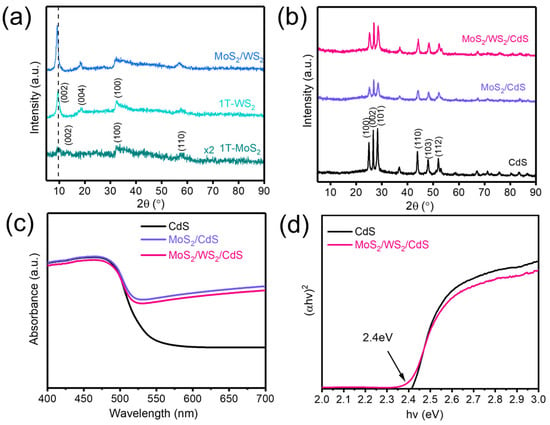
Figure 1.
XRD patterns of (a) 1T-MoS2, 1T-WS2 and MoS2/WS2; (b) XRD patterns and (c) DRS spectra of CdS, MoS/CdS and MoS2/WS2/CdS; (d) Tauc plot curves of CdS and MoS2/WS2/CdS.
The morphology and structure of MoS2, MoS2/WS2 and MoS2/WS2/CdS composites were analyzed using SEM and TEM. As shown in Figure 2a, the prepared 1T-MoS2 is a microsphere aggregated by nanosheets with a size of about 500 nm. After loading 1T-WS2, MoS2/WS2 is still a microsphere structure stacked by nanosheets (Figure 2b). From the TEM image of MoS2/WS2/CdS (Figure 2c), the rod-like CdS is tightly wrapped with MoS2/WS2, which results in the close contact between CdS and MoS2/WS2. From the HRTEM image (Figure 2d), a lattice spacing of 0.995 nm can be observed, which belongs to the (002) plane of 1T-WS2 []. The lattice spacing of the (002) crystal plane of 1T-WS2 in MoS2/WS2/CdS is larger than that of 1T-WS2 (0.94 nm) in MoS2/WS2, which may be due to the entry of Cd atoms into the lattice of WS2 during the formation of CdS. The lattice spacing belonging to 1T-MoS2 was not found in TEM, which is due to the packaging of 1T-WS2. Additionally, the lattice spacing of 0.35 nm belonging to the (100) plane of CdS can also be observed [], indicating that CdS is successfully loaded on the surface of MoS2/WS2. The mapping (Figure 2e) shows Cd, S, Mo and W elements, indicating that the ternary cross-linked MoS2/WS2/CdS photocatalyst with close interfacial contact was prepared successfully.
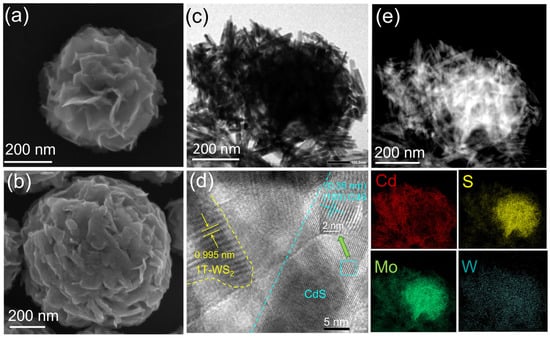
Figure 2.
SEM images of (a) MoS2 and (b) MoS2/WS2; (c) TEM, (d) HRTEM and (e) EDX mapping of MoS2/WS2/CdS.
The element composition and chemical states of MoS2/WS2/CdS were examined via XPS. As shown in Figure 3, the characteristic element peaks belonging to MoS2, WS2 and CdS can be observed from the XPS survey spectra. In the HRXPS spectra of Cd 3d, the peaks at 405.8 eV and 412.5 eV belong to 3d5/2 and 3d3/2 of Cd2+, respectively []. In the HRXPS spectra of Mo 3d, the peaks at 228.0 eV and 232.5 eV correspond to 3d5/2 and 3d3/2 of Mo of 1T-MoS2, and the peaks at 229.2 eV and 233.5 eV correspond to 2H-MoS2, indicating that there is a small amount of 2H-MoS2 in the synthesized MoS2, and the peak belonging to S 2s can be observed at 226.5 eV [,]. It can be clearly observed from the XPS spectrum of W 4f that two peaks appear at 30.8 eV and 34.0 eV, which are very consistent with the 4f7/2 and 4f5/2 of W4+ of 1T-WS2, indicating that 1T-WS2 is successfully grown on the surface of 1T-MoS2, which is consistent with the XRD results. Similarly, the appearance of peaks at 31.9 eV and 35.9 eV suggests the presence of 2H-WS2, and the peak at 37.7 eV belongs to the peak of the oxidation peak of W6+ [,,]. S 2p contains S 2p3/2 and S 2p1/2 orbitals, in which the binding energies of 162.3 eV and 163.6 eV match those of S2− []. The XPS results further confirm the synthesis of MoS2/WS2/CdS.
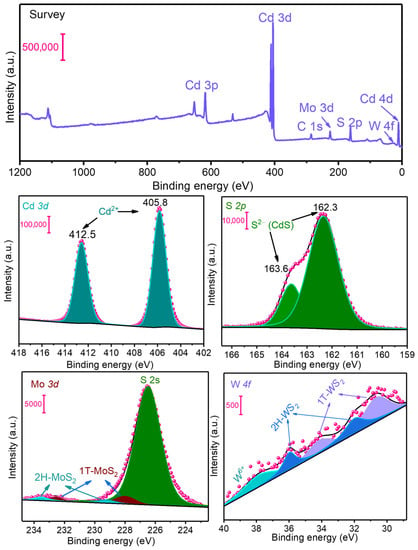
Figure 3.
XPS survey spectrum of MoS2/WS2/CdS and HRXPS spectra of Cd 3d, Mo 3d, W 4f and S 2p.
The photocatalytic hydrogen evolution activity of the samples was tested under 300 W (λ > 420 nm) Xe lamp irradiation. As shown in Figure 4, the photocatalytic hydrogen evolution rate of CdS is only 2.65 mmol·g−1·h−1, which is due to the lack of active sites. The photogenerated carriers of CdS quickly recombine on the surface instead of reducing protons to produce hydrogen due to the high overpotential of hydrogen evolution on the surface of CdS. After the introduction of MoS2, the photocatalytic hydrogen evolution rate increased to 8.78 mmol·g−1·h−1. This is because the photogenerated electrons generated by CdS will be quickly transferred to the surface of MoS2 due to the difference in Fermi level, thereby improving the separation efficiency of photogenerated charges. Interestingly, after loading the dual cocatalyst MoS2/WS2, the hydrogen evolution rate of the ternary cocatalyst MoS2/WS2/CdS was further improved. When the loading amount is 4%, the hydrogen evolution rate of the 2:1 MoS2/WS2/CdS composite reaches 12.12 mmol·g−1·h−1, which is 4.57 times that of CdS. Benefitting from the heterojunction between MoS2 and WS2, the photogenerated electrons generated by CdS are transferred to WS2 and then quickly transferred to MoS2, thereby synergistically improving the photogenerated charge separation efficiency and photocatalytic hydrogen evolution activity.
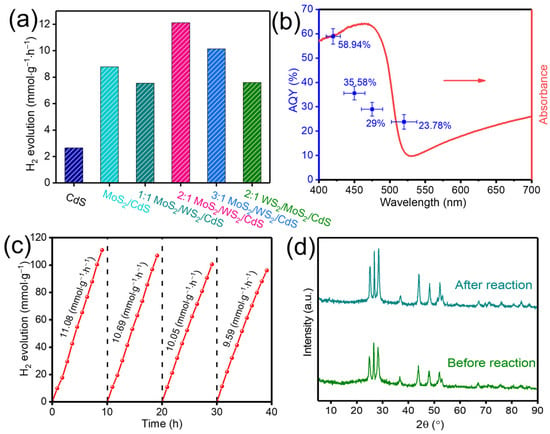
Figure 4.
(a) H2 evolution rates of CdS, MoS2/CdS, MoS2/WS2/CdS and WS2/MoS2/CdS; (b) single wavelength AQYs and (c) cyclic experiment of 2:1 MoS2/WS2/CdS toward H2 evolution; (d) XRD patterns of 2:1 MoS2/WS2/CdS before and after reaction for 40 h.
In addition, the mass ratio of MoS2 to WS2 also affects the cocatalytic performance of MoS2/WS2. When the mass ratio of WS2 in MoS2/WS2 is increased (1:1) or decreased (3:1), the photocatalytic hydrogen evolution rates of the ternary MoS2/WS2/CdS are significantly reduced. This may be because when WS2 grows too thick on the surface of MoS2, it is difficult for photogenerated electrons to quickly transport to MoS2 through WS2, thus reducing a charge separation efficiency and resulting in a decrease in the photocatalytic hydrogen evolution rate. When the loading amount of WS2 is too low, the synergistic effect of MoS2/WS2 is weakened, thus reducing the hydrogen evolution activity. In addition, to explore the electron transfer pathway, the effects of the growth order of WS2 and MoS2 on the photocatalytic hydrogen evolution activity were investigated. MoS2/WS2 and WS2/MoS2 cocatalysts were synthesized, respectively, and CdS was grown in situ on the surface of the two cocatalysts for photocatalytic hydrogen production. The results show that the photocatalytic hydrogen evolution activity of WS2/MoS2/CdS is not only lower than that of MoS2/WS2/CdS, but also lower than that of MoS2/CdS. This result suggests that the photogenerated electrons are quickly transferred from CdS to MoS2 and then further transferred to WS2. On the contrary, the electrons transferred from CdS to WS2 are difficult to transfer to MoS2.
To obtain comparable hydrogen evolution performance, the hydrogen evolution rates and corresponding AQYs of 2:1 MoS2/WS2/CdS at different wavelengths were investigated, as shown in Figure 4b and Table 1. At λ = 420 nm, the AQY of 2:1 MoS2/WS2/CdS is about 58.9%, which indicates that MoS2/WS2 has excellent cocatalytic performance. To explore the photocatalytic stability of MoS2/WS2/CdS, the cyclic experiment of the 2:1 MoS2/WS2/CdS catalyst was carried out. As shown in Figure 4c, during the 40 h continuous reaction (four cycles), the hydrogen evolution rate only slightly decreased from 11.08 mmol·g−1·h−1 to 9.59 mmol·g−1·h−1, which was attributed to the consumption of lactic acid. Moreover, the XRD spectra of MoS2/WS2/CdS before and after the reaction did not change (Figure 4d), indicating that the photocatalyst has high structural stability.

Table 1.
Main data for obtaining AQYs of 2:1 MoS2/WS2/CdS under different wavelengths.
The kinetics of photogenerated carrier separation was studied through PL spectroscopy and photoelectrochemical tests. Considering the recombination process of photoinduced electrons and holes, the generated energy is emitted in the form of fluorescence []. Therefore, the separation efficiency of photogenerated carriers can be reflected by the PL intensity of the sample. As shown in Figure 5a, the PL intensity of CdS is the strongest, implying the strongest charge recombination. After loading the MoS2 cocatalyst, the PL intensity of the MoS2/CdS becomes weaker. Obviously, the MoS2/WS2/CdS possesses the weakest PL intensity, suggesting that the MoS2/WS2 cocatalyst further promotes the separation of photogenerated electron–hole pairs []. To explore the reason why MoS2/WS2 functions as an active site for hydrogen evolution, linear sweep voltammetry (LSV), electrochemical impedance spectroscopy (EIS) and transient photocurrent response (i-t) were performed. From the LSV curves of the sample (Figure 5b), CdS exhibits a high onset potential for H2 evolution and a lower reduction current density, indicating that there is a high hydrogen evolution overpotential and slow hydrogen evolution kinetics on the CdS surface []. The loading of MoS2 and MoS2/WS2 can reduce the onset potential for H2 evolution, indicating that the H2 evolution reaction is more likely to occur on the surface of cocatalysts. From the EIS plots of the samples (Figure 5c), the semi-circular diameter of the loaded CdS is smaller than that of pristine CdS, indicating that the interfacial resistance of electron transfer becomes smaller [,]. The semi-circular diameter of MoS2/WS2/CdS is smaller than that of MoS2/CdS, indicating that the synergistic effect of MoS2/WS2 further promotes the hydrogen evolution kinetics. In addition, from the i–t curves of the photocatalysts (Figure 5d), it can be seen that, compared with CdS, loaded CdS shows stronger photocurrent density and MoS2/WS2/CdS has the strongest photocurrent density, further indicating that the synergistic effect of MoS2/WS2 promotes the separation efficiency of carriers.
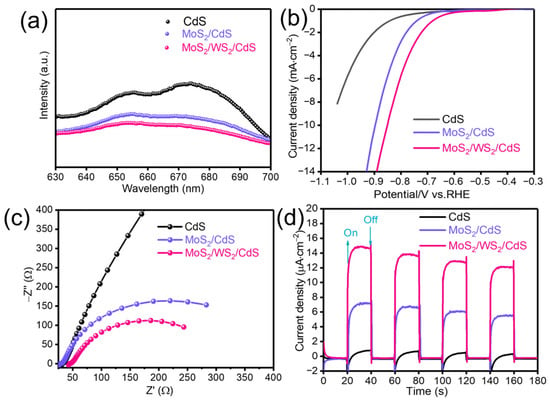
Figure 5.
(a) PL spectra, (b) LSV curves, (c) EIS plots and (d) photocurrent response (i-t) of CdS MoS2/CdS and MoS2/WS2/CdS.
The lifetime of photogenerated carriers of the MoS2/WS2/CdS photocatalyst was studied using the time-resolved photoluminescence (TRPL) technique. The average PL lifetime can be used to reflect the separation efficiency of photogenerated electrons and holes []. The double exponential function was used to fit the emission decay curve as shown in Figure 6, and the average lifetimes (τave) of the CdS and MoS2/WS2/CdS were calculated. The lifetime of MoS2/WS2/CdS (3.45 ns) is shorter than that of CdS (4.25 ns), implying that the photogenerated electrons generated by CdS quickly transfer to MoS2/WS2, which improves the separation rate of electrons and holes, thereby enhancing the photocatalytic hydrogen evolution activity [,].
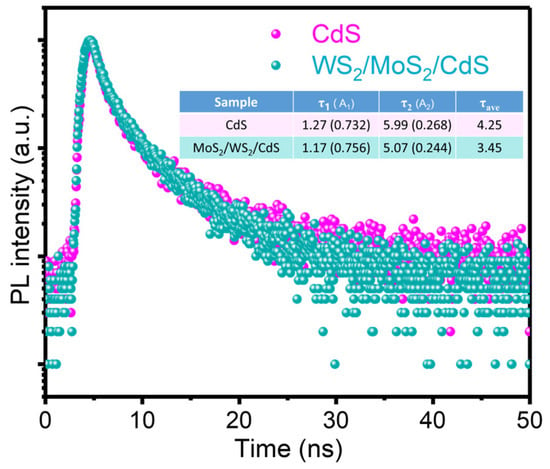
Figure 6.
TRPL spectra and lifetimes of CdS and MoS2/WS2/CdS.
To better explain the charge separation dynamics of MoS2/WS2/CdS, the flat band potentials of 1T-WS2, MoS2/WS2 and CdS were measured using the Mott–Schottky technique (Figure 7). The M–S curves of CdS, 1T-WS2 and 1T-MoS2 have a positive slope, indicating that they are n-type semiconductors with flat band potentials of −1.4 V, −0.4 V and −0.4 V, respectively [,]. The flat band potential of 1T MoS2 is very close to that of 1T WS2 (−0.4 V), which can be attributed to the similar structure of 1T MoS2 and 1T WS2. In addition, the flat band potential of MoS2/WS2 equals that of 1T-WS2. For an n-type semiconductor, since the flat band potential approaches the CB potential of the catalyst, the CB potentials of CdS and MoS2/WS2 are −1.4 V and −0.4 V, respectively [,]. Based on the above results, the possible mechanism of photocatalytic hydrogen evolution on MoS2/WS2/CdS was proposed (Figure 7c). Under the excitation of light, electrons in VB of CdS are excited to the CB, and then migrate to the surface of CdS to reduce protons to H2. The holes remain on the VB and are consumed by the sacrificial reagent. However, due to the lack of active sites on the surface of CdS, most of the electrons and holes are rapidly recombined, which results in low photocatalytic activity. After loading MoS2/WS2, since the CB potential of WS2 is lower than that of CdS, the electrons on the CB of CdS are easily transferred to the surface of WS2 through the close contact interface between WS2 and CdS. Importantly, due to the Schottky junction between WS2 and MoS2, some of the photogenerated electrons on WS2 further migrate to the surface of MoS2. Benefiting from the synergistic effect between WS2 and MoS2, the separation efficiency of carriers is improved, thereby enhancing the photocatalytic hydrogen evolution activity.
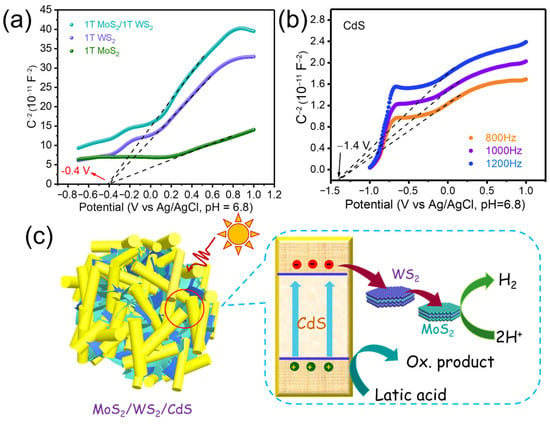
Figure 7.
Mott–Schottky curves of (a) 1T-WS2, 1T MoS2, MoS2/WS2 and (b) CdS; (c) illustration showing the mechanism for enhanced photocatalytic activity over MoS2/WS2/CdS.
3. Experimental
3.1. Preparation of Photocatalysts
3.1.1. Preparation of 1T-MoS2
To prepare 1T-MoS2, 0.284 g of (NH4)6Mo7O24·4H2O and 0.568 g of CH4N2S were dissolved in 30 mL of deionized water, and 1 g of SiO2 was slowly added to the above solution under stirring. Then, the mixture was put into a 45 mL polytetrafluoroethylene-lined autoclave and maintained at 210 °C for 18 h. The obtained black solid was fully washed with ethanol and water and dried at 60 °C for 12 h to form 1T-MoS2/SiO2. An appropriate amount of HF aqueous solution was added to the dried black solid to remove SiO2. After soaking for 6 h, the black 1T-MoS2 solid was obtained.
3.1.2. Preparation of MoS2/WS2
MoS2/WS2 cocatalysts were synthesized by means of a solvothermal method. Typically, 0.2 g of MoS2 was ultrasonically dispersed in 25 mL of DMF, and then 0.28 g of WCl6 and 0.529 g of TAA were dissolved in the mixture. After ultrasonic treatment for 0.5 h, the mixture was transferred into a 45 mL polytetrafluoroethylene-lined autoclave and maintained at 200 °C for 24 h. The MoS2/WS2 black solid with a mass ratio of 2:1 was obtained by washing it with deionized water and ethanol. By changing the mass ratio of 1T-MoS2 and 1T-WS2, 1:1 MoS2/WS2 and 3:1 MoS2/WS2 were prepared, respectively.
3.1.3. Preparation of MoS2/WS2/CdS
The MoS2/WS2/CdS photocatalysts were obtained by means of the in situ growth of rod-like CdS on MoS2/WS2 using a solvothermal method. In this process, 0.0376 g of MoS2/WS2 (2:1) was ultrasonically dispersed in 48 mL of C2H8N2 (EDA). Then, 1.54 g of Cd(NO3)2·4H2O and 1.14 g of CH4N2S were added to the mixture. The mixture was transferred into a 45 mL polytetrafluoroethylene-lined autoclave and maintained at 160 °C for 48 h. The samples were washed with water and ethanol and dried at 40 °C in a vacuum oven to obtain 4% MoS2/WS2/CdS. Using the same method, 1:1 MoS2/WS2/CdS and 3:1 MoS2/WS2/CdS were prepared. As a comparison, MoS2/CdS was prepared using the above method. In addition, MoS2 was grown in situ on the surface of WS2 via the above method to prepare 2:1 WS2/MoS2, and the then 2:1 WS2/MoS2/CdS photocatalyst was prepared as a comparison. Of note, in this paper, the loading amounts of the cocatalysts for all photocatalysts are 4%.
3.2. Characterization
The crystal structures of the samples were verified by collecting X-ray diffraction (XRD) patterns on a Bruker-AXS diffractometer with a Cu Kα radiation source (λ = 0.15406 nm). The morphology of the photocatalysts was investigated using field emission scanning electron microscopy (FESEM) (Carl Zeiss GeminiSEM300, Zeiss, Oberkochen, Germany) and transmission electron microscopy (TEM, JEM-F200, JEOL, Tokyo, Japan). The UV-Vis diffuse reflection spectra (DRS) were acquired using an ultraviolet-visible-near-infrared spectrophotometer (UH4150, HITACHI, Tokyo, Japan). The surface electronic states were analyzed via X-ray photoelectron spectroscopy (XPS), which was performed with a Thermo Fisher Scientific K-Alpha spectrometer (Thermo Fisher Scientific, MA, USA) using a monochrome aluminum Kα source (hv = 1486.6 eV). The sample was measured in a sample chamber. After the pressure was lower than 2.0 × 10−7 mbar, the sample was sent to the chamber for analysis using a 12 kV working voltage and 6 mA filament current. The HRXPS spectra of each element were fitted using XPSpeak 4.1 software based on Gauss–Lorentz curve fitting. The adventitious C 1s at 284.8 eV was applicable to calibrate the binding energy (BE) values. Photoluminescence (PL) and time-resolved PL (TRPL) spectra were recorded with a single photon counting spectrometer from an FLS980 fluorescence spectrometer with an excitation wavelength of 325 nm (Edinburgh Instruments, Livingston, UK).
3.3. Photoelectrochemical Measurements
The linear sweep voltammetry (LSV), photocurrent response (i-t) and electrochemical impedance spectroscopy (EIS) measurements were performed using a CH Instrument 760 E electrochemical workstation (Shanghai Chenhua Instrument, Shanghai, China), using a 0.5 mol·L−1 Na2SO4 aqueous solution as an electrolyte. A platinum wire was used as a counter electrode and an Ag/AgCl electrode was used as a reference electrode. In this process, 5 mg of catalyst was dispersed in 1.5 mL of 0.1 wt% nafion solution to form a slurry. The working electrodes were prepared by coating the slurry onto ITO conducting glass (1 × 1 cm2) and dried at 25 °C overnight. A 300 W Xe lamp was used to provide visible light (λ > 420 nm). The Mott–Schottky (M-S) curve was measured on a CHI760E electrochemical workstation. The working electrodes were prepared by coating the slurry onto a glassy carbon electrode (3 mm diameter, 0.07 cm2) and dried at 25 °C overnight.
3.4. Photocatalytic Performance Evaluation System
The reaction was carried out in a 350 mL reactor that was kept at 25 °C via the circulation of cooling water. The photocatalytic hydrogen evolution rates were tested under 300 W (λ > 420 nm) xenon lamp irradiation. Each 50 mg photocatalyst was ultrasonically dispersed in a 65 mL aqueous solution of lactic acid (20%). Before irradiation, the reactor was vacuumed using a vacuum pump. The hydrogen production performance was tested using a gas chromatograph. The amount of generated H2 was tested at intervals of 1 h using an on-line GC (TCD detector, Ar as the carrier gas). The AQYs of the 4% MoS2/WS2/CdS photocatalyst at λ= 420 nm, 450 nm, 475 nm and 520 nm were examined using bandpass filters and an irradiatometer (CEL-NP2000) according to the equations below:
where nH2 is the evolution rate of hydrogen molecules, mol/s; L is the Avogadro constant, 6.02 × 1023 mol−1; I is the irradiance at λ = 400 nm, 420 nm, 450 nm, and 520 nm, W·m−2; A is the illuminated area, m2; E is the photon energy, eV; h is the Plank’s constant, 6.63 × 10−34, J·s; and c is the speed of light, 3 × 108 m·s−1.
4. Conclusions
The MoS2/WS2 cocatalyst was prepared by means of the in situ growth of 1T-WS2 on the surface of 1T-MoS2 via a solvothermal method. The ternary cross-linked MoS2/WS2/CdS photocatalysts with close interfacial contact were constructed by growing CdS nanorods on MoS2/WS2 using a solvothermal method. Benefiting from the excellent synergistic effect of MoS2 and WS2, the MoS2/WS2 cocatalyst further improves the separation efficiency of photogenerated electrons and holes and enhances the catalytic activity. The hydrogen evolution rate of 2:1 MoS2/WS2/CdS photocatalyst reaches 12.12 mmol·g−1·h−1, which is 4.57 times that of CdS, and the AQY at λ = 420 nm is 58.9%. This study provides an effective strategy for the construction of dual cocatalysts with high cocatalytic performance.
Author Contributions
Conceptualization, Y.S. and B.W.; methodology, B.W.; validation, Y.S. and B.W.; investigation, Y.S., B.W., X.L. and L.G.; resources, L.G. and W.S.; writing—original draft preparation, Y.S. and B.W.; writing—review and editing, X.L., L.G. and W.S.; supervision, X.L. and L.G.; project administration, W.S.; funding acquisition, W.S. All authors have read and agreed to the published version of the manuscript.
Funding
This research was funded by The Natural Science Foundation of China (21773153).
Data Availability Statement
The data presented in this study are available on request from the corresponding authors.
Conflicts of Interest
The authors declare no conflict of interest.
References
- Chi, J.; Jiang, Z.; Yan, J.; Larimi, A.; Wang, Z.; Wang, L.; Shangguan, W. Recent advancements in bismuth vanadate photoanodes for photoelectrochemical water splitting. Mater. Today Chem. 2022, 26, 101060. [Google Scholar] [CrossRef]
- Yan, Y.; Chen, Z.; Cheng, X.; Shi, W. Research Progress of ZnIn2S4-Based Catalysts for Photocatalytic Overall Water Splitting. Catalysts 2023, 13, 967. [Google Scholar] [CrossRef]
- He, Y.; Dai, X.; Ma, S.; Chen, L.; Feng, Z.; Xing, P.; Yu, J.; Wu, Y. Hydrothermal preparation of carbon modified KNb3O8 nanosheets for efficient photocatalytic H2 evolution. Ceram. Int. 2020, 46, 11421–11426. [Google Scholar] [CrossRef]
- Shen, R.; Ren, D.; Ding, Y.; Guan, Y.; Ng, Y.; Zhang, P.; Li, X. Nanostructured CdS for efficient photocatalytic H2 evolution: A review. Sci. China Mater. 2020, 63, 2153–2188. [Google Scholar] [CrossRef]
- Mirsalari, S.A.; Nezamzadeh-Ejhieh, A.; Massah, A.R. A designed experiment for CdS-AgBr photocatalyst toward methylene blue. Environ. Sci. Pollut. Res. 2022, 29, 33013–33032. [Google Scholar] [CrossRef]
- Bie, C.; Fu, J.; Cheng, B.; Zhang, L. Ultrathin CdS nanosheets with tunable thickness and efficient photocatalytic hydrogen generation. Appl. Surf. Sci. 2018, 462, 606–614. [Google Scholar] [CrossRef]
- Cai, M.; Cao, S.; Zhuo, Z.; Wang, X.; Shi, K.; Cheng, Q.; Xue, Z.; Du, X.; Shen, C.; Liu, X.; et al. Fabrication of Ni2P Cocatalyzed CdS Nanorods with a Well-Defined Heterointerface for Enhanced Photocatalytic H2 Evolution. Catalysts 2022, 12, 417. [Google Scholar] [CrossRef]
- Li, X.; Gao, Y.; Li, N.; Ge, L. In-situ constructing cobalt incorporated nitrogen-doped carbon/CdS heterojunction with efficient interfacial charge transfer for photocatalytic hydrogen evolution. Int. J. Hydrogen Energy 2022, 47, 27961–27972. [Google Scholar] [CrossRef]
- Li, S.; Wang, L.; Li, Y.; Zhang, L.; Wang, A.; Xiao, N.; Gao, Y.; Li, N.; Song, W.; Ge, L.; et al. Novel photocatalyst incorporating Ni-Co layered double hydroxides with P-doped CdS for enhancing photocatalytic activity towards hydrogen evolution. Appl. Catal. B 2019, 254, 145–155. [Google Scholar] [CrossRef]
- Coogan, Á.; Gun’ko, Y.K. Solution-based “bottom-up” synthesis of group VI transition metal dichalcogenides and their applications. Mater. Adv. 2021, 2, 146–164. [Google Scholar] [CrossRef]
- Teo, W.Z.; Chng, E.L.; Sofer, Z.; Pumera, M. Cytotoxicity of exfoliated transition-metal dichalcogenides (MoS2, WS2, and WSe2) is lower than that of graphene and its analogues. Chem. Eur. J. 2014, 20, 9627–9632. [Google Scholar] [CrossRef] [PubMed]
- Anto Jeffery, A.; Nethravathi, C.; Rajamathi, M. Two-dimensional nanosheets and layered hybrids of MoS2 and WS2 through exfoliation of ammoniated MS2 (M = Mo, W). J. Phys. Chem. C 2014, 118, 1386–1396. [Google Scholar] [CrossRef]
- Zou, Y.; Guo, C.; Cao, X.; Zhang, L.; Chen, T.; Guo, C.; Wang, J. Synthesis of CdS/CoP hollow nanocages with improved photocatalytic water splitting performance for hydrogen evolution. J. Environ. Chem. Eng. 2021, 9, 106270. [Google Scholar] [CrossRef]
- Xiang, Q.; Cheng, F.; Lang, D. Hierarchical layered WS2/graphene-modified CdS nanorods for efficient photocatalytic hydrogen evolution. ChemSusChem 2016, 9, 996–1002. [Google Scholar] [CrossRef]
- Zhang, X.; Yang, P.; Jiang, S. Horizontally growth of WS2/WO3 heterostructures on crystalline g-C3N4 nanosheets towards enhanced photo/electrochemical performance. J. Nanostruct. Chem. 2021, 11, 367–380. [Google Scholar] [CrossRef]
- Zhang, Z.; Li, Q.; Qiao, X.; Hou, D.; Li, D. One-pot hydrothermal synthesis of willow branch-shaped MoS2/CdS heterojunctions for photocatalytic H2 production under visible light irradiation. Chin. J. Catal. 2019, 40, 371–379. [Google Scholar] [CrossRef]
- Zhang, Y.; Guo, S.; Xin, X.; Song, Y.; Yang, L.; Wang, B.; Tan, L.; Li, X. Plasmonic MoO2 as co-catalyst of MoS2 for enhanced photocatalytic hydrogen evolution. Appl. Surf. Sci. 2020, 504, 144291. [Google Scholar] [CrossRef]
- Ding, C.; Zhao, C.; Cheng, S.; Yang, X. Ultrahigh photocatalytic hydrogen evolution performance of coupled 1D CdS/1T-phase dominated 2D WS2 nanoheterojunctions. Chin. J. Catal. 2022, 43, 403–409. [Google Scholar] [CrossRef]
- Reddy, D.A.; Park, H.; Hong, S.; Kumar, D.P.; Kim, T. Hydrazine-assisted formation of ultrathin MoS2 nanosheets for enhancing their co-catalytic activity in photocatalytic hydrogen evolution. J. Mater. Chem. A 2017, 5, 6981–6991. [Google Scholar] [CrossRef]
- Feng, C.; Chen, Z.; Jing, J.; Sun, M.; Tian, J.; Lu, G.; Ma, L.; Li, X.; Hou, J. Significantly enhanced photocatalytic hydrogen production performance of g-C3N4/CNTs/CdZnS with carbon nanotubes as the electron mediators. J. Mater. Sci. Technol. 2021, 80, 75–83. [Google Scholar] [CrossRef]
- Liang, Z.; Yang, S.; Wang, X.; Cui, H.; Wang, X.; Tian, J. The metallic 1T-phase WS2 nanosheets as cocatalysts for enhancing the photocatalytic hydrogen evolution of g-C3N4 nanotubes. Appl. Catal. B 2020, 274, 119114. [Google Scholar] [CrossRef]
- Su, L.; Luo, L.; Song, H.; Wu, Z.; Tu, W.; Wang, Z.; Ye, J. Hemispherical shell-thin lamellar WS2 porous structures composited with CdS photocatalysts for enhanced H2 evolution. Chem. Eng. J. 2020, 388, 124346. [Google Scholar] [CrossRef]
- Chen, W.; Liu, X.; Wei, S.; Heng, Q.; Wang, B.; Liu, S.; Gao, L.; Mao, L. In situ growth of a-few-layered MoS2 on CdS nanorod for high efficient photocatalytic H2 production. Front. Energy 2021, 15, 752–759. [Google Scholar] [CrossRef]
- Kim, H.U.; Kim, M.; Seok, H.; Park, K.Y.; Moon, J.Y.; Park, J.; An, B.S.; Jung, H.; Dravid, V.; Whang, D.; et al. Realization of wafer-scale 1T-MoS2 film for efficient hydrogen evolution reaction. ChemSusChem 2021, 14, 1344–1350. [Google Scholar] [CrossRef] [PubMed]
- Wang, S.; Li, Y.; Hu, Y.; Zhou, X.; Zhang, M.; Jia, X.; Lin, B.; Chen, G. One-step synthesis of 1T MoS2 hierarchical nanospheres for electrocatalytic hydrogen evolution. ACS Appl. Energy Mater. 2022, 5, 11705–11712. [Google Scholar] [CrossRef]
- Yi, J.; She, X.; Song, Y.; Mao, M.; Xia, K.; Xu, Y.; Mo, Z.; Wu, J.; Xu, H.; Li, H. Solvothermal synthesis of metallic 1T-WS2: A supporting co-catalyst on carbon nitride nanosheets toward photocatalytic hydrogen evolution. Chem. Eng. J. 2018, 335, 282–289. [Google Scholar] [CrossRef]
- Srinivaas, M.; Wu, C.Y.; Duh, J.G.; Wu, J. Highly rich 1T metallic phase of few-layered WS2 nanoflowers for enhanced storage of lithium-ion batteries. ACS Sustain. Chem. Eng. 2019, 7, 10363–10370. [Google Scholar] [CrossRef]
- Kim, M.J.; Jeon, S.J.; Kang, T.W.; Ju, J.M.; Yim, D.; Kim, H.I.; Park, J.; Kim, J.H. 2H-WS2 quantum dots produced by modulating the dimension and phase of 1T-nanosheets for antibody-free optical sensing of neurotransmitters. ACS Appl. Mater. Interfaces 2017, 9, 12316–12323. [Google Scholar] [CrossRef]
- Xiong, T.; Cen, W.; Zhang, Y.; Dong, F. Bridging the g-C3N4 interlayers for enhanced photocatalysis. ACS Catal. 2016, 6, 2462–2472. [Google Scholar] [CrossRef]
- Heng, Q.; Wang, B.; Fan, X.; Chen, W.; Li, X.; Mao, L.; Shangguan, W. Enhanced photoreduction activity of CO2 to CO over Ag-loaded mesoporous g-C3N4 (MCN) by promoting charge separation and CO2 adsorption. J. Alloys Compd. 2022, 920, 165945. [Google Scholar] [CrossRef]
- Li, F.; Yang, J.; Gao, J.; Liu, Y.; Gong, Y. Enhanced photocatalytic hydrogen production of CdS embedded in cationic hydrogel. Int. J. Hydrogen Energy 2020, 45, 1969–1980. [Google Scholar] [CrossRef]
- Song, T.; Hou, L.; Long, B.; Ali, A.; Deng, G.J. Ultrathin MXene “bridge” to accelerate charge transfer in ultrathin metal-free 0D/2D black phosphorus/g-C3N4 heterojunction toward photocatalytic hydrogen production. J. Colloid Interface Sci. 2021, 584, 474–483. [Google Scholar] [CrossRef] [PubMed]
- Chen, W.; Wang, Y.; Shangguan, W. Metal (oxide) modified (M = Pd, Ag, Au and Cu) H2SrTa2O7 for photocatalytic CO2 reduction with H2O: The effect of cocatalysts on promoting activity toward CO and H2 evolution. Int. J. Hydrogen Energy 2019, 44, 4123–4132. [Google Scholar] [CrossRef]
- Heng, Q.; Ma, Y.; Wang, X.; Wu, Y.; Li, Y.; Chen, W. Role of Ag, Pd cocatalysts on layered SrBi2Ta2O9 in enhancing the activity and selectivity of photocatalytic CO2 reaction. Appl. Surf. Sci. 2023, 632, 157564. [Google Scholar] [CrossRef]
- Lu, X.; Chen, W.; Yao, Y.; Wen, X.; Hart, J.; Tsounis, C.; Toe, C.; Scott, J.; Ng, Y. Photogenerated charge dynamics of CdS nanorods with spatially distributed MoS2 for photocatalytic hydrogen generation. Chem. Eng. J. 2021, 420, 127709. [Google Scholar] [CrossRef]
- Chen, R.; Wang, P.; Chen, J.; Wang, C.; Ao, Y. Synergetic effect of MoS2 and MXene on the enhanced H2 evolution performance of CdS under visible light irradiation. Appl. Surf. Sci. 2019, 473, 11–19. [Google Scholar] [CrossRef]
- Li, L.; Gao, D.; Chen, F.; Wang, X.; Yu, H. Amorphization-crystallization synergism on MoSx homojunction for boosting photocatalytic H2 production of TiO2 in alkaline medium. Appl. Surf. Sci. 2023, 608, 155173. [Google Scholar] [CrossRef]
- Guan, Y.; Wu, J.; Lin, Y.; Liu, Q.; Qi, Y.; Pan, W.; He, P.; Qi, X.; Wang, R.; Ji, Z. Solvent-exfoliation of transition-metal dichalcogenide MoS2 to provide more active sites for enhancing photocatalytic performance of BiOIO3/g-C3N4 photocatalyst. Appl. Surf. Sci. 2019, 481, 838–851. [Google Scholar] [CrossRef]
- Wang, B.; Sun, Y.; Fan, X.; Chen, W.; Liu, X.; Gao, L.; Mao, L. In situ growth of 1T-WS2 on ultrathin Ti3C2Tx as a hybrid cocatalyst for enhancing the photocatalytic activity of CdS. Appl. Surf. Sci. 2023, 615, 156305. [Google Scholar] [CrossRef]
- Fan, X.; Wang, B.; Heng, Q.; Chen, W.; Mao, L. Facile in-situ synthesis of a-NiS/CdS p-n junction with enhanced photocatalytic H2 production activity. Int. J. Hydrogen Energy 2022, 47, 32531–32542. [Google Scholar] [CrossRef]
Disclaimer/Publisher’s Note: The statements, opinions and data contained in all publications are solely those of the individual author(s) and contributor(s) and not of MDPI and/or the editor(s). MDPI and/or the editor(s) disclaim responsibility for any injury to people or property resulting from any ideas, methods, instructions or products referred to in the content. |
© 2023 by the authors. Licensee MDPI, Basel, Switzerland. This article is an open access article distributed under the terms and conditions of the Creative Commons Attribution (CC BY) license (https://creativecommons.org/licenses/by/4.0/).